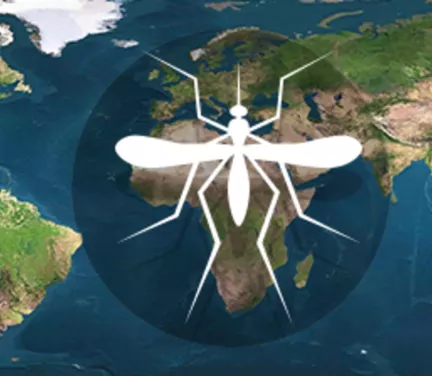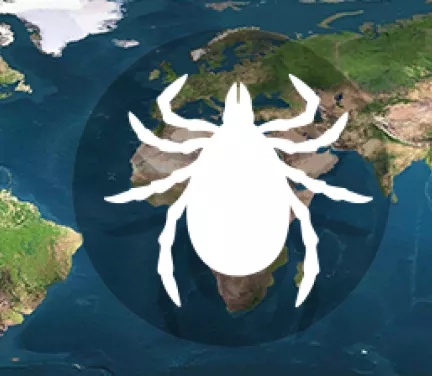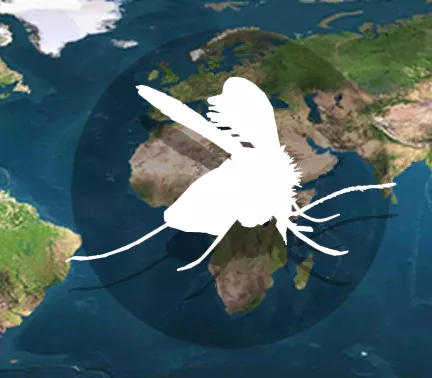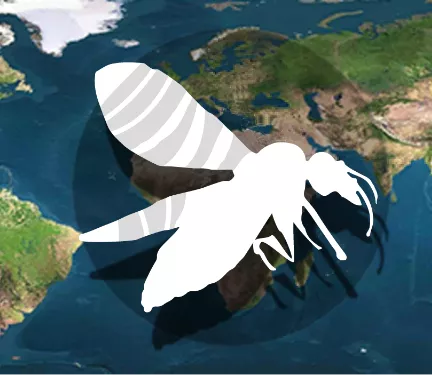Vector-borne diseases


A vector A carrier of a disease-causing agent from an infected individual to a non-infected individual or its food or environment; for example, mosquitoes carrying malaria parasites is a living organism A living thing such as humans, animals, plants and microbes (e.g. bacteria, viruses) that transmits an infectious agent from an infected animal to a human or another animal. Vectors are frequently arthropods, such as mosquitoes, ticks, flies, fleas and lice.
Vectors can transmit infectious diseases either actively or passively:
- Biological vectors, such as mosquitoes and ticks may carry pathogens that can multiply within their bodies and be delivered to new hosts, usually by biting.
- Mechanical vectors, such as flies can pick up infectious agents on the outside of their bodies and transmit them through physical contact.
Diseases transmitted by vectors are called vector-borne diseases. Many vector-borne diseases are zoonotic A term given to diseases and infections that can be transmitted between animals and humans diseases, i.e. diseases that can be transmitted directly or indirectly between animals and humans. These include for example Lyme disease, tick-borne encephalitis, West Nile virus, Leishmaniosis and Crimean-Congo haemorrhagic fever.
Many vector-borne diseases are considered as emerging infectious diseases in the European Union:
- a disease that appears in a population Community of humans, animals or plants from the same species for the first time, or
- that may have existed previously but is rapidly increasing in incidence The number of new events occurring within a specified time period within a defined geographical area; for example, the number of flu cases per year in Europe or geographic range.
Some vectors are able to move considerable distances. This may affect the transmission ranges of vector-borne zoonotic diseases. Vectors can be introduced to new geographic areas for example by:
- travel of humans and international trade;
- animal movement, for instance of livestock;
- migratory birds;
- changing agricultural practices;
- or the wind.
Other factors may play a role in their establishment and persistence Persistence refers to the ability of harmful organisms like bacteria to survive and thrive despite regular cleaning and disinfection efforts, potentially lingering in hidden places for months or even years in new areas, including climatic conditions.
Latest
Since July 2025, EFSA and ECDC have been publishing monthly automated online reports on West Nile Virus, providing updates on human infections and outbreaks in birds and equids. Joint surveillance efforts help public health and veterinary authorities in Europe implement timely and effective control measures.
EFSA's role
EFSA and its Panel on Animal Health and Welfare provide independent scientific advice and scientific assistance on human health and animal health-related aspects of vector-borne zoonotic diseases. EFSA monitors and analyses the situation on zoonoses, zoonotic micro-organisms, antimicrobial resistance The ability of microorganisms (such as bacteria, viruses, fungi) to survive exposure to antimicrobials. This phenomenon, driven largely by the overuse and misuse of antimicrobial agents (e.g. antibiotics, fungicides used as plant protection agents, etc), makes infections harder to treat and poses a significant threat to public health., microbiological contaminants and food-borne outbreaks across Europe.
EFSA works with European Centre for Disease Prevention and Control (ECDC), sharing information on present and future projects on vectors and vector-borne zoonotic diseases.
Based on data collected by the EU Member States, EFSA and ECDC produce annual European Union summary reports on vector-borne zoonoses in animals and food-borne outbreaks caused by these micro-organisms.
Disease Profiles
EFSA has produced interactive disease profiles that provide user-friendly and evidence-based information on vector-borne diseases. The disease profiles are updated through seven living systematic reviews covering: 1) Geographic Distribution; 2) Experimental Infections; 3) Vaccination Efficacy How well something works in relation to predefined standards or expectations; 4) Pathogen Organism (e.g. bacterium, virus and parasite) that can cause disease Survival; 5) Diagnostic Test Accuracy 6) Vector Control and 7) Treatment Efficacy. When sufficient studies are found and reviewed, a meta-analysis A statistical method which enables the results of similar studies to be pooled in order to determine any significant trends is carried out automatically on the extracted data and the results are visualised in the disease profiles. In addition, links to other risk assessments on the diseases carried out by EFSA are provided.
Please check our video for a short demonstration of the disease profiles.
Living systematic reviews covering Vector-borne disease
Check out the vector-borne disease profilesVectorNet
In 2014 EFSA and ECDC launched VectorNet, a joint initiative that supports the collection of data on vectors and pathogens in vectors, related to both animal and human health.
In 2025, ECDC and EFSA launched a new data portal in cooperation with the Global Biodiversity A term used to describe the variety of living organisms existing in a specific environment Information Facility (GBIF), to centralise vector distribution data, foster global collaboration and open access for all users.
The One Health project also provides ad-hoc scientific advice to ECDC and EFSA on technical questions about vector surveillance and vector-borne diseases in humans and animals.
The project will contribute to improving preparedness and response to vector-borne diseases in the European Union. Stay up to date on the latest activities of VectorNet and subscribe to our newsletter.
Vector maps
The VectorNet project database of ECDC and EFSA provides information on the European distribution of several mosquitoes, ticks, sandfly and biting midges species A subdivision of the genus, a species is a group of closely related and similar-looking organisms; for example, in the case of Homo sapiens (humans), the second part of the name (sapiens) represents the species, which can be vectors of pathogens affecting human or animal health. The maps are based on confirmed data (published and unpublished) provided by experts, and do not represent the official position of the countries.
| Mosquito maps | The maps show the current known distribution of several invasive and native mosquito species in Europe at 'regional' administrative level (NUTS3). |  |
| Tick maps | The maps show the current known distribution of several tick species in Europe at 'regional' administrative level (NUTS3). |  |
| Sandfly maps | The maps show the current known distribution of several sandfly species in Europe at 'regional' administrative level (NUTS3). |  |
| Biting midge maps | The maps show the current known distribution of several biting midge species in Europe at ‘regional’ administrative level (NUTS3). |  |
Please contact vectornet [at] ecdc.europa.eu (vectornet[at]ecdc[dot]europa[dot]eu) if you have relevant information pertaining the vector distribution maps.
EU framework
According to EU legislation, many infectious diseases have to be notified by Member States to either national authorities or the European Commission. They are managed by various control, eradication and prevention measures. EU policy on communicable diseases focuses on surveillance, rapid detection and rapid response.
An EU network for the epidemiological surveillance and control of communicable diseases has been in place since 1999. EU surveillance includes some important vector-borne zoonotic diseases, such as malaria, the West Nile virus and yellow fever. In addition, ECDC has a specific programme on emerging and vector-borne diseases.
In the area of animal health, one of the key elements of the Community Animal Health Policy is the early detection of exotic, new and emerging disease threats.